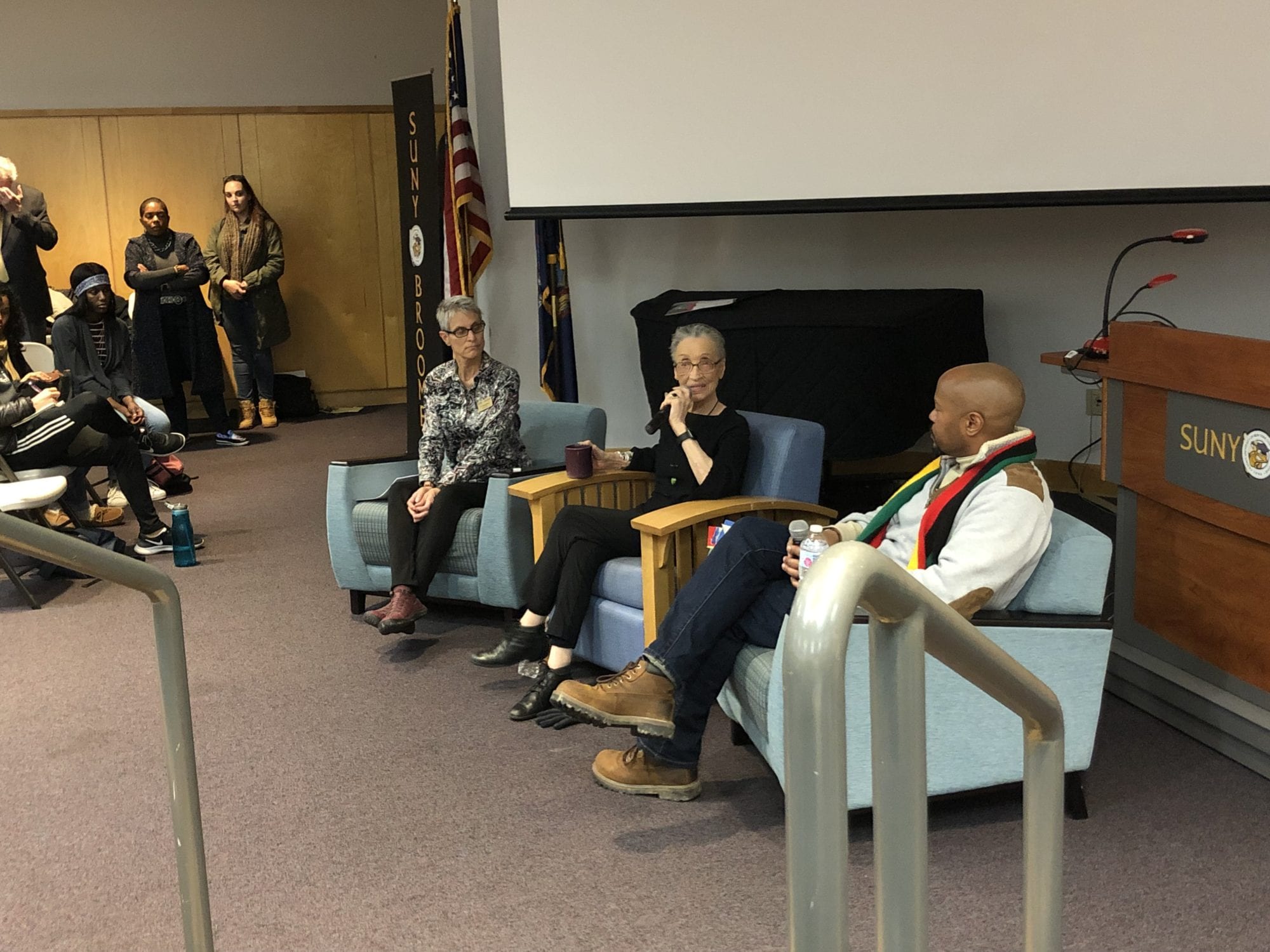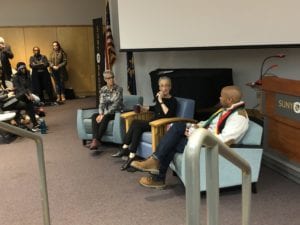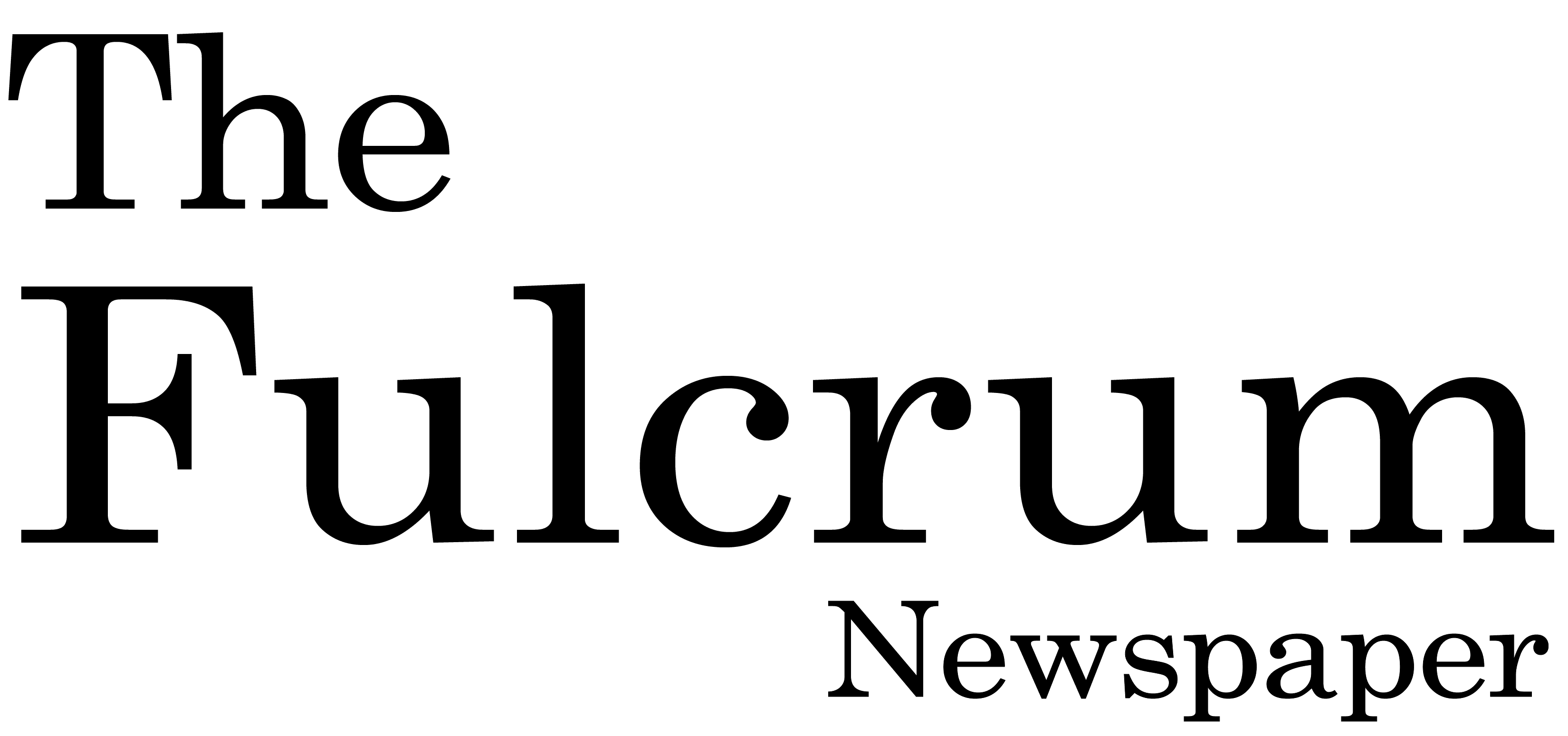Whether you realize it or not, the decisions you make today – who to vote for or whether to vote at all, whether to speak up, what career you will follow – will shape the future for generations to come. The problem is, mused Betty Reid Soskin, you won’t know exactly how until decades afterward.
“Tomorrow is shaped by what we do or fail to do today,” she told a standing-room only crowd in SUNY Broome’s Decker Health Sciences Room 201 on Nov. 14. “These periods of chaos are cyclical and they’ve been happening since 1776.”
At 97 years old, Soskin is the nation’s oldest National Park ranger – and it’s not an honorary post. She works five days a week at the Rosie the Riveter/World War II Home Front National Historical Park in Richmond, California, giving talks and conducting tours. Before becoming a park ranger at the age of 85, the mother, grandmother and musician had a wide and varied life, including founding and running a record store, serving as a community activist, writing songs for the Civil Rights movement, fundraising for the Black Panthers and, later, serving as a field representative for two California state assemblywoman, which led to her involvement in the future park.
In short, Soskin has a birds-eye view of American history, stemming from her long years of experience. During an intimate conversation with Soskin led by Professors Virginia Shirley and Scott Corley, a rapt and silent audience hung on her every word.
“You’re really killing it here today!” one young man exclaimed during the question and answer portion.
“Thank you!” Soskin said with a laugh.
Forgotten history
The story behind the park is a fascinating one. It preserves the legacy of the home front struggle during World War II and specifically the Kaiser Richmond shipyards, which built 747 ships in three years and eight months, effectively out-producing the enemy, Soskin explained. Henry Kaiser imported his 98,000-member workforce from the South, both black and white, to a city with a population of only 23,000.
The massive productivity opened job opportunities to women and minorities – including the white, iconic “Rosie the Riveter” types – but came at a significant cost of lives in industrial accidents: a tally of 37,600 during the home front initiative. There were other costs, too: the 2½ years that Japanese-Americans spent in internment simply because they looked like the enemy. The Port Chicago explosion in California, in which 320 men – mostly black dockworkers – lost their lives when a munitions ship exploded. Afterward, 50 dockworkers refused to continue working out of fear of future explosions – and were convicted of mutiny and sentenced to 15 years in prison, the first time the nation had conducted a group trial of that sort, Soskin said.
“There’s so much history that was forgotten,” she said.
Soskin, whose parents were from Louisiana, identifies herself as “poly-racial” but in the world of her day, she was considered black. During the time of the shipyards, she worked as a clerk in a Jim Crow-segregated union hall and never saw a ship being built or launched.
When the park was being proposed around 2000, Betty Reid Soskin stepped forward to offer her own remembrances: the racial segregation and realities of the time, for example. To her surprise, she found a roomful of planners listening to her seriously. They were perhaps among the first generations to grow up with Sesame Street and Mr. Rogers, which normalized diversity and benefited the cause of Civil Rights.
“I have the incredible sense now that my fingerprints are all over that park. Without knowing I was doing it, I shaped a national park,” she said.
Redefining democracy
Soskin and her first husband moved to the suburbs to build a home and raise their family – the only black family in the neighborhood, where they faced bias and threats. As society changed, so did their reception, she remembered; she eventually became the friend white liberals wanted to have, to prove their dedication to Civil Rights.
She was politically active through the tumult of the 1960s – a period she is much reminded of today. “Those periods of chaos are when democracy are being redefined,” she said.
Due to her longevity, she is now living in the future she helped create – and largely, it’s a good one. She gives programs in Silicon Valley, where diversity is assumed, for example. Even tough moments – such as the white supremacists rallying in Charlottesville – reflect positive developments: the masks and hoods are off, and diverse groups are uniting to fight white supremacy, she reflected.
It’s true that today’s students must meet the challenges of their generation, such as climate change, with a flawed social system. That was also true during the World War II home front effort, Soskin reflected.
“There have always been those people in the system who are trying to get it right. The thrust of history is positive,” she said, pointing out that her great-grandmother was born a slave in 1846, before the Dred Scott decision. The family connection isn’t just academic; Soskin knew her great-grandmother as the matriarch of her family, and she died when the younger woman was 27.
Named one of Glamour Magazine’s Women of the Year this fall, Soskin documented her life experiences in a memoir, Sign My Name to Freedom, and gives talks via Skype to book clubs around the country. She is still learning new things at the age of 97, and wishes she could have a few more decades to see the changes to come.
“I have no idea where we’re going to end up, but I think we’re on the right track,” she said. “Democracy has been a successful experiment for all of the woes, but we have to take our place in it.”






